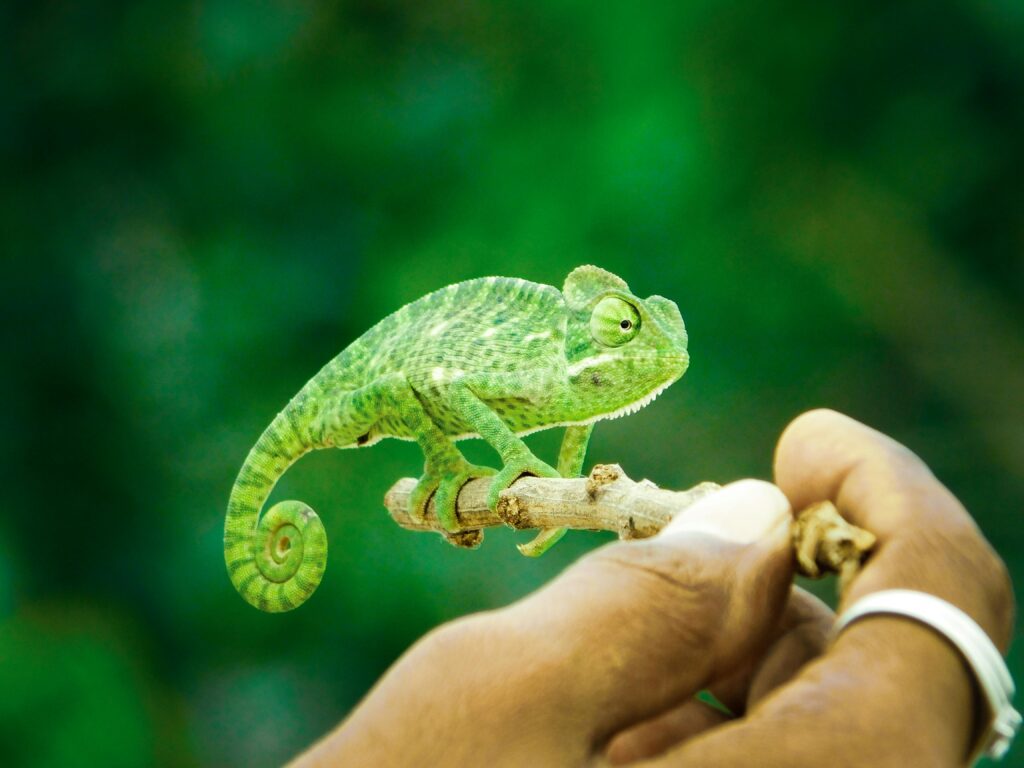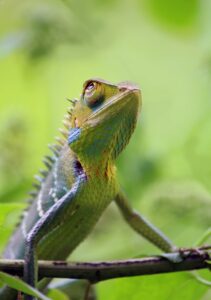Jackson's Chameleon Care Guide
Published: February 5th, 2024
Known for their captivating, mini dinosaur-like appearance, Jackson’s chameleons have become a popular choice in the pet trade since the 1980s. These fascinating creatures offer a unique and rewarding experience for intermediate to advanced hobbyists who are dedicated to providing proper care.

Lifespan
Jackson’s chameleons typically have an average lifespan of 4 to 8 years, with males generally living longer than females.
Size:
The Yellow-crested Jackson’s chameleon (C.j. xantholophus) is the most commonly found among the three available species. Hatchlings start at 3-4 inches and reach sexual maturity between 5 to 8 months.
Males, larger at 8-12 inches, develop the distinctive triceratops appearance with three horns on their heads, while females, smaller at 7-8 inches, lack the horned features.
Download the Caresheet |
Natural History:
Endemic to Africa, particularly East Africa for C.j. xantholophus, these chameleons have also been introduced to Hawaii, Florida, and California. Contrary to popular belief, chameleons do not instantly change color to match their background but use color changes for emotional expression, heat absorption, and environmental camouflage. Jackson’s chameleons are viviparous, giving birth to live offspring.
Housing:
The enclosure size depends on the age and sex of the chameleon. While baby chameleons do well in smaller enclosures, adult Jackson’s chameleons require a minimum semi-screened enclosure size of 24”W x 24”L x 36”H throughout their lives.
Ensure adequate height for these arboreal creatures, and house them separately if caring for multiple chameleons.
Lighting & Heating:
 Maintaining a healthy temperature gradient is crucial for thermoregulation. For Jackson’s chameleons, a basking temperature of 85-90°F at the top of the enclosure is recommended, with a vine or branch placed a safe distance away. Ambient daytime temperatures should be around 80°F, never dropping below 60°F at night. Humidity levels should stay between 50-80%. Use white incandescent basking bulbs for appropriate temperatures and consider ceramic heat emitters for supplemental heat.
Maintaining a healthy temperature gradient is crucial for thermoregulation. For Jackson’s chameleons, a basking temperature of 85-90°F at the top of the enclosure is recommended, with a vine or branch placed a safe distance away. Ambient daytime temperatures should be around 80°F, never dropping below 60°F at night. Humidity levels should stay between 50-80%. Use white incandescent basking bulbs for appropriate temperatures and consider ceramic heat emitters for supplemental heat.
It’s essential to provide UVB light for the absorption and metabolism of calcium and D3. Aim for modest UVA/UVB exposure to mimic a natural day/night cycle, showcasing your pet’s vibrant colors. Regularly measure temperatures and humidity at different points within the enclosure using digital thermometers and hygrometers.
By dedicating time and effort to these unique reptiles, you can ensure a fulfilling experience as a responsible Jackson’s chameleon owner.
Substrates & Cage Décor:
Chameleons, being arboreal creatures, thrive in environments that provide ample opportunities for climbing. Incorporate sandblasted manzanita, wooden dowels, and artificial vines into their habitat to create climbing structures. Both live and artificial plants serve as visual barriers and contribute to maintaining humidity levels within the enclosure.
Secure décor using suction cups, magnetic potting ledges (for glass walls), or employ creative methods like floral/jewelry wire, zip ties, or Dragon Ledges (for screen walls). Balancing creativity with safety is key when decorating your chameleon’s habitat.
Chameleons seldom drink from water bowls, necessitating an alternative hydration approach. Mist the enclosure 3-4 times daily using a hand sprayer or pressurized pump sprayer. Drippers can provide a continuous water source, and an automatic rain system, though pricier, offers humidity spikes and hydration throughout the day. Ensure intermittent dry periods between misting to prevent constant wetness. Proper drainage, possibly using a drip pan, prevents water accumulation at the enclosure’s base.
Diet & Nutrition:
Chameleons are insectivores, thriving on appropriately sized and gut-loaded crickets, dubia roaches, mealworms, black soldier larvae, etc. Superworms and hornworms can be occasional treats. Feed younger chameleons twice a day, allowing them to consume within 10 minutes, with food no larger than the space between their eyes. Older chameleons may be fed 4-5 times weekly.
Supplementation varies, but a quality calcium w/D3 and multivitamin at each feeding is generally recommended. Coat insects by placing them and dusting powder into a bag or tin, shaking gently to cover them. Offer food in an escape-proof cup, drop it into the enclosure, or tong-feed.
Handling & Temperament:
Avoid handling your chameleon until it has acclimated to its new environment, which may take several weeks. Jackson’s chameleons are generally more tolerant of handling, making them suitable for beginners, but individual temperament varies. Handle your chameleon as often as it comfortably allows, watching for signs of stress such as color changes, hissing, puffing up, biting behavior, or refusal to eat.
If uncertain about your chameleon’s comfort with handling, err on the side of caution and allow it to be an exquisite display animal in your home.
Download the caresheet for Jackson's Chameleon |

Recent Posts
- All Post
- care sheets
- guide
- Lizards
- snakes
- Uncategorized
- Back
- Mourning Gecko
- Sandfish skink
- Tegu
- Ackie Monitor lifespan
- Bearded dragon
- Blue Tongue Skink
- Crested Gecko
- Gargoyle Gecko
- Jackson's Chameleon
- Leopard Gecko
- Back
- Ball Python
- Black Rat Snake
- Corn Snake
- Gila Monster
- kenyan sand boa
- Milk Snake
- Back
- lizardscs
- snakescs



Address
215 Woodland Ave. Manchester, NH 03102




